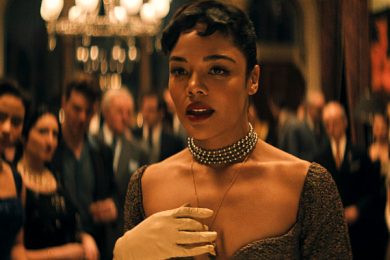Ema has had a strained journey to American screens. Stalled by the pandemic, the film from Chilean maestro Pablo Larraín was stalled for over a year, only to be dumped at the end of Summer, a ghost of a presence amongst more high profile releases, including Larraín’s own Spencer, his Princess Diana biopic starring Kristen Stewart slated for release later this year. So Ema goes from a film festival darling to a curious appetizer before bigger things to come. Which is a shame, because this is a powerful film to behold. Strange, erotic and bursting with chest-pounding dance music, Ema has a little bit of everything, including Larraín’s eye for sense-shattering imagery.
Ema (Mariana Di Girolamo) is a dancer. She’s married to Gastón (Gael García Bernal), the director of the company that she performs in. Gastón puts together intricate productions of abstract expression; dark stages with colorful lights and inexplicable body movements. Ema prefers reggaetón, known for its heavy bass and its latin-and-hip-hop-infused beats that sound closer to what you hear on the streets. Ema and Gastón have much larger problems in their relationship – they’re on the verge of a divorce – but all of their fights seem to stem from this molecular personality difference. Gastón is an artist seeking perfection and Ema is a performer seeking exhilaration.
The couple had a son named Polo that they adopted, but the film starts just after they decided to return him to the orphanage. Polo is rarely seen but his presence is a ghost that haunts their lives and conversations. There are references to anguish and guilt, suggestions of violence and pyromania. Ema’s sister is in the hospital after sustaining burns from a fire that Polo started, and when a friend’s cat is found dead in a freezer, everyone knows who the culprit is. Or do we? Throughout the film, Ema’s behavior is erratic and unpredictable. One of her preferred hobbies is going around town with a flame thrower and sending random objects up in flames with no apparent motive. Gastón is controlling and inflexible, but he always has the upper hands in their arguments. He can cruelly remind her of her failure as a mother.
As per usual, Larraín foregoes explanations, and much of Ema truly becomes about its protagonist’s mercurial volatility. Her feelings in one scene may contradict the feelings in the next. Larraín’s direction, ultra stylized and awash in bruising neon colors (wondrous cinematography by Sergio Armstrong), is incredibly subjective, deep within Ema’s psyche, jumbled amongst odd feelings of grief and misplaced passion. This is portrayed through the wondrous performance of Di Girolamo, whose trust in Larraín’s conceptual ideas gives this sometimes opaque story a real heart. There’s a lot about Ema that seems unforgivable, but the performance’s simultaneous confidence and vulnerability creates a fully realized person. Her mind games and carnal explorations are hard to comprehend as the story unfolds, but Larraín and Di Girolamo hold the audience in place, much like Ema holds her marks in her intricate spider’s web.
This is an odd curio of a movie from a director who loves to keep his audience at arm’s length. Like in Neruda and Jackie, he prefers cinematic explanations to narrative ones. Those films were about historical figures, and despite their own free-wheeling techniques, still held a slight feeling of fidelity to its subject matter and the historical record. There are no obligations with Ema, which moves liberally from one sequence to the next, sparing the audience much explanation until the end when Ema’s noir-ish scheme is revealed in full. The resolution does feel a bit like patchwork – perhaps even a betrayal of the disjointed story that preceded it, providing a payoff that was perhaps not needed – but this is a stunning visual journey into complicated feelings seldom explored in movies today.
Directed by Pablo Larraín










